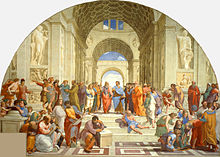Monocular vision
Under monocular vision or monocular vision (to ancient Greek μόνος Mónos alone 'and Latin oculus , eye), also monovision called, refers to the permanent or temporary seeing with only one eye due to functional or organic monocular vision . This also includes the alternating (alternating) use of two eyes independently of one another and without functional interconnection.
In contrast, binocular vision is a skill that allows simultaneous vision with both eyes on the basis of a neural relationship system, the so-called retinal correspondence. Only normal two-eyed vision enables three-dimensional spatial vision . But even when seeing with one eye alone, the brain can create the impression of three-dimensionality. This monocular depth perception is occasionally differentiated as psychological from the physiological in binocular vision. However, with monocular vision, the blind spot cannot be compensated for by corresponding retinal regions.
Causes of Monocular Vision
People who are potentially capable of binocular vision can temporarily prevent it by closing one eye or wearing an eye patch. In addition to such one-eyed vision, e.g. as part of a visual field examination ( perimetry ) or a therapeutic measure ( occlusion ), various causes can lead to monocular vision. For example, in many mammals as well as birds and lizards, an “alternating” monocular vision with great all-round vision can be observed, which allows possible dangers to be better recognized.
Permanent monocular vision can be the result of injuries and illnesses, such as anophthalmia or high anisometropia . The most common cause of the pathological lack of binocular vision in humans and thus monovision, however, is strabismus .
A new refractive-surgical aid for the treatment of presbyopia , the so-called KAMRA implant , creates an artificial monovision that improves visual acuity in the medium close range, but leads to the loss of three-dimensional spatial vision.
Monocular depth perception

There are a number of cues or depth criteria , which also mediate among monovision the impression of stereopsis. These deep stimuli are differentiated according to whether they are dependent on the movement of the observer or the objects. One then speaks of either pictorial or image-related or movement- induced depth stimuli .
Motion parallax
The motion parallax is an effect that results visually when different subjects at different distances are considered in a landscape, and the observer is traveling about to the objects so on in parallel move seem.
Atmospheric perspective
Atmospheric perspective means the influence that an atmosphere specific in terms of density and composition has on the perceived appearance of an object viewed from a distance. For example, the contrast between the object and the background decreases or the color tone changes.
Occlusion and interposition
Covering and covering or occlusion describe the fact that objects that are further in front can cover other objects behind, not the other way around. The staggered arrangement of partially covered objects shows whether one object is in front of or behind others. One speaks of interposition when it stands between two others, covering one and covered by another.
Perspective convergence
Structures that are parallel to one another seem - viewed in perspective - to approach and converge with increasing distance, to converge. This perspective convergence can give the impression that parallels meet at a distant point (see also perspective and central projection ).
Texture gradient
The structure of a surface is interpreted as depth if similar elements of a structure are denser in a certain direction and become smaller (more elements per unit area), for example upwards.
Relative size
One and the same object appears smaller to an observer if it is further away from him.
However, an image of the retina of the same size can also be created by objects of different sizes if they are differently far apart. This can be the case with the moon and the sun disk , for example .
The distance to objects can be estimated poorly without further information, even if retinal images of different sizes can be generated by objects of the same size.
Further depth criteria are
- Familiar sizes
- Relative height
- shadow
Individual evidence
- ^ Herbert Kaufmann: Strabismus. 3rd fundamentally revised and expanded edition, with the collaboration of W. de Decker et al., Georg Thieme Verlag, Stuttgart, New York 2003, ISBN 3-13-129723-9
- ↑ Opinion of the Refractive Surgery Commission of the DOG and the BVA , May 2011 ( Memento of the original from January 24, 2013 in the Internet Archive ) Info: The archive link has been inserted automatically and has not yet been checked. Please check the original and archive link according to the instructions and then remove this notice. (PDF; 170 kB)
- ↑ David G. Myers: Psychology . Springer Berlin Heidelberg; Edition: 2nd exp. u. updated edition (July 14, 2008). ISBN 978-3540790327 . Page 267–269
- ^ Richard J. Gerrig, Philip G. Zimbardo: Psychology . Addison-Wesley Verlag; Edition: 18th, updated edition (March 20, 2008). ISBN 978-3827372758 . Page 148/149
- ^ Robert S. Siegler: The thinking of children . Oldenbourg Wissenschaftsverlag; Edition: 3 (January 11, 2001). ISBN 978-3486255942 . Page 158
- ^ E. Bruce Goldstein: Perceptual Psychology: The Basic Course . Spectrum Academic Publishing House; Edition: 7th edition (October 24, 2007). ISBN 978-3827417664 . Page 187-189
Web links
- 6.2 Monocular depth criteria - examples of monocular depth criteria at the University of Heidelberg







